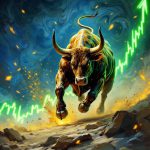Market Carnage Unleashed: The Peril of Herd Mentality
Stop. Read this before you lose everything. In the crucible of financial markets, fear is not just an emotion—it is a weapon of mass destruction, wielded unconsciously by the panicked herd. At the peak of chaos, when red numbers scream from every screen, human biology takes over. Fight-or-flight hijacks rationality. Investors, institutional and retail alike, become a stampede, trampling their own portfolios in a blind rush to the exits.
History’s graveyard is littered with the victims of this collective madness. The Crash of 1929, Black Monday in 1987, and the Financial Crisis of 2008 each mark a chapter where fear cascades through trading floors like wildfire. There is a pattern: the deeper the panic, the greater the opportunity for those who refuse to submit. If you wish to survive, you must learn how to identify market reversals using the best trend change indicator, because it is in these extremes that fortunes are both lost and forged.
The Psychological Roots of Market Panic
It is easy to dismiss market crashes as rare, external shocks. The truth is uglier: irrational cascades are hardwired into our collective psyche. Nobel laureates Daniel Kahneman and Amos Tversky exposed the cognitive biases that trap traders—loss aversion, confirmation bias, and the irresistible urge to conform. Like a flock of startled birds, investors react not to the facts, but to each other’s reactions.
In 2008, as Lehman Brothers collapsed and liquidity evaporated, even seasoned professionals succumbed to the herd instinct. Hedge funds liquidated positions en masse, margin calls triggered automated selling, and the market spiralled downward with terrifying speed. In the aftermath, those who had mastered identifying market reversals using the best trend change indicator stood atop the rubble, having seized the moment when all others fled.
This is the paradox: The more universal the fear, the greater the mispricing. The more the crowd screams “sell!”, the more likely a reversal looms. Market dynamics are not linear—they are vector fields of human emotion, liquidity, and information, colliding in unpredictable patterns.
Contrarian Mastery: Harnessing the Fear
What separates the masters from the casualties? The ability to move against the herd at the moment of peak terror. Warren Buffett’s dictum—“Be fearful when others are greedy, and greedy when others are fearful”—is not mere folklore. It is a battle-tested principle, proven in the heat of market collapses.
But let’s go deeper. Charlie Munger dissected human nature ruthlessly, arguing that “invert, always invert”—if the crowd is paralyzed by fear, the logical contrarian is emboldened. Jesse Livermore, the legendary speculator, made and lost fortunes by reading the psychological temperature of the market, waiting for that flash of irrationality that signals exhaustion and imminent reversal.
To operate at this level requires more than bravado. One must systematically learn how to identify market reversals using the best trend change indicator, looking beyond price alone to the invisible vectors—volume surges, volatility spikes, and sentiment collapse. The real edge lies in the outliers, not the averages.
Fear-Exploiting Strategies: Engineering Alpha From Panic
Now, to the heart of the matter: Strategies that monetise fear. One of the most potent weapons in the contrarian arsenal is the sale of put options during volatility spikes. When panic grips the market, put premiums soar—reflecting not just risk, but naked terror.
For example, during the COVID-19 crash of March 2020, the VIX spiked above 80. Deep out-of-the-money puts on blue-chip stocks fetched absurdly inflated premiums. A disciplined trader, armed with the knowledge of how to identify market reversals using the best trend change indicator, could sell these puts, pocketing rich premiums while avoiding catastrophic downside (by selecting only stocks with fortress balance sheets and robust cash flows).
What next? Reinvest the collected premiums into LEAPS (Long-term Equity Anticipation Securities). This is where leverage meets prudence. By allocating the option income to long-dated call options, you amplify exposure to the inevitable recovery, risking a defined amount but capturing unlimited upside.
Imagine selling $10,000 worth of puts during a volatility spike, collecting $2,500 in premiums. That $2,500 buys out-of-the-money LEAPS on the same stock. If the stock rebounds sharply within two years, the LEAPS can return multiples, supercharging your gains, with the initial put sale cushioning your cost basis. It’s a calculated asymmetry: limited risk, outsized potential.
Disciplined Boldness: The Contradiction at the Core
Here lies the greatest paradox: True contrarian success demands both audacity and restraint. The unthinking rebel, charging against the herd without preparation, is simply another victim—crushed under the wheels of volatility.
Meticulous planning is non-negotiable. This means stress-testing every scenario, sizing positions conservatively, and setting ironclad stop-losses. Emotional discipline is equally critical. The market is a psychological battleground; your greatest enemy is not the crowd, but your own limbic system.
Remember: how to identify market reversals using the best trend change indicator is never a mechanical formula. It is an evolving synthesis of price action, volume, volatility, macroeconomic signals, and—above all—sentiment extremes. The indicator itself is not a crystal ball; it is a compass, guiding you through the fog, but only if you have the courage to follow it.
Consider Ray Dalio, whose “principled” approach to risk management was forged in the crucible of repeated failure and introspection. Or Paul Tudor Jones, who insists on “losing small” and waiting for the asymmetric trade. These are not gamblers—they are engineers of uncertainty, embracing paradox, thriving in contradiction.
Vector Thinking: Markets as Multi-Dimensional Battlefields
Let us abandon the myth of markets as simple, linear systems. Financial markets are hyper-connected, non-linear, and multi-dimensional. Every price tick is the emergent outcome of countless intersecting forces—flows of capital, cross-asset correlations, policy shocks, technological disruption, and the shifting moods of billions.
To master how to identify market reversals using the best trend change indicator, one must think like a physicist, not a bookkeeper. Consider the analogy of turbulence in fluid dynamics: the tiniest eddy can trigger a cascade, just as a single margin call can spark a market-wide rout.
This is where edge case exploration becomes indispensable. Instead of focusing on the “average” move, look for the structural weak points—the leverage hidden in opaque corners, the crowded trades, the liquidity mismatches. The outliers are where the reversals begin, and where the best trend change indicator flashes its rarest, most valuable signals.
In mythology, the hero descends into chaos, finds the golden thread, and emerges transformed. So too must the investor plunge into the heart of volatility, trusting in their preparation and the clarity of their tools.
Emergent Synthesis: Beyond the Indicator
It is not enough to possess the best trend change indicator. The real power is unlocked only when you recognise how multiple signals interact—momentum, mean reversion, macro catalysts, market structure, and mass psychology.
When the stochastic oscillator signals oversold, volume surges to historic highs, and sentiment surveys hit record pessimism, you are seeing an emergent property—a market stretched to its breaking point, primed for reversal. Single indicators can fail, but their convergence reveals a deeper pattern.
This is the paradox at the heart of trading: Certainty is an illusion; probability is your only ally. Risk cannot be eliminated, only managed. The best trend change indicator is not a shield against loss, but a sword for striking in the chaos—if and only if you wield it with discipline and vision.











